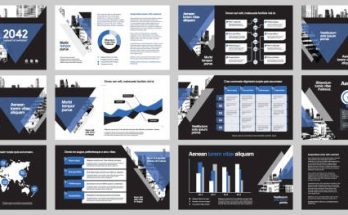Typography is not only about selecting the best-quality typeface for the text. It is important in determining the likely image and tone of a brand before it is delivered to the customers. Typography is a powerful tool whenever a brand selects a font that captures both its ethos and its target demographic preferences; How Typography Transformed a Brand’s Image is a tale of how a company can make thoughtful design choices that transcend simple, visual appeal and into the spheres of passion and loyalty.
Typography a Stationary or Printing Fundamental Piece in the Grand Branding Puzzle
Typography concerns the emotions the customers experience when they are in touch with a given brand. Typeface influences sentiments, controls the flow of users’ attention, and illustrates brand character. For example, a sophisticated and shiny font without the curves of a serif font will look innovative and trendy, whereas a serif font has a hint of tradition in it. The right fonts matter when a brand wants to communicate its values and foster relationships with the viewers.
Case Study:
When the Lindenmeyer Munroe Company embarked on its quest to redefine itself and its image, it did so in grand style, bringing typography, which is defined as the art of printing on the meaning of the company, and it all started with the company’s slogan.
To illustrate how typography transformed a brand’s image, it is necessary to analyze the rebranding process of a fictitious company that is a skincare brand, PureFlow, which produces organic products. PureFlow had brilliant products, and they enjoyed the patronage of many valued clients but failed to capture their primary values’ representation through visual imagery. Its previous typography was not fitting its personality and created a rather segregated and utterly uncoordinated brand image.
Initial Brand Challenges
This paper highlights various branding issues that afflicted the promotional strategy of PureFlow, which manages a luxury carwash service. Some of the main issues included:
Mismatched Font Style
The first logo of PureFlow had text created with a nondescript generic sans-serif typeface that did not convey the company’s positioning of the brand as naturally superior skincare. The font seemed too formal and bureaucratic, which did not match with the company’s bio-organic image.
Lack of Visual Cohesion
The typography used for this brand was incongruous across platforms, thus creating confusion and hindering clients from easily identifying with PureFlow. This resulted in brand incongruity, which in turn had an effect on the brand confusion of the organization’s brands.
Ineffective User Engagement
The typography failed to appeal to customers and did not appeal to what customers wanted. Consequently, PureFlow received a low traffic of visitors to the firm’s website and social media platforms; most customers did not bond with the brand.
The Redesign Process: Features that defined Pure Flow’s preceding appearance are eliminated so as to be replaced by typography, a concept explored further in the subsequent section.
These concerns are related to the fact that, to deal with them, Pure Flow had to partner with a branding agency focused on typography. This way the agency supported them in their understanding of their target audiences, brand values, and positioning to define fonts that would be closer to their identity.
Step 1: The subject of brand personality and values
As for the PureFlow brand personality, known attributes were sustainability, simplicity, and elegance. The need was to identify typography that would reflect these values. The team chose two primary fonts: a serif style for the logo to achieve class and a new style sans serif style for the main text to achieve a natural and professional look.
Step 2: Selecting the Fonts
To create a cohesive and memorable image, Pure Flow chose the following typography approach:
Logo Font: Cormorant Garamond (Serif): The serif font introduced a sort of class to it, which allowed Pure Flow to brand itself as a quality-oriented brand.
Body Font: Nunito (Sans serif): This font also made it look informal and welcoming, which is perfect for the brand’s environmentally friendly nature. Its smooth curvatures made it to resemble objects found in nature, and this was in line with the company’s aims and goals in the usage of natural foods.
Step 3: Establishing Visual Hierarchy
This meant that, like other graphic design elements such as color, PureFlow made sure that typography provided focus: customers were able to glance through and spot what the designers wanted to bring to their attention. The active headlines were done in the serif style to draw people’s attention to them, while passive text in the sans-serif style made the mini text more easily readable.
Step 4: Testing Across Platforms
Finally, to guarantee the coherence of the implementation, the team experimented with the new typography on websites, coverings, social media accounts, and the company’s weekly newsletters of Pure Flow. Steady use of fonts further helps towards the memorability of the brand, which in turn lays down a robust professionalism on Purposeful image.
The Results: Transforming PureFlow’s Image using Typography
In the case of Pure Flow, the firm focused on redesigning its typography to improve the brand opinion and encourage customers to engage with the brand. Here’s how typography transformed Purposeful image:
Improved Brand Recognition
Customers then soon remembered what Purposeful new logo and typography was all about—that is, if they saw it at all. The serif letters also used in the logo added to the message of luxury and reliability, whereas the clear sans-serif of the true text body made the information accessible and readable.
Increased Customer Engagement
By having typography that was in line with the company’s values, social media engagement for Purposeful as well as the website experienced a boost. It contributed to an increase in customer engagement to other content that featured the brand because of the neat typography used to produce the Purposeful logo, which made it believable.
Stronger emotional connection
This theory must have worked for Purposeful because the use of serif and sans-serif fonts in the logo encouraged the right emotions among the customers. The serif typeface targeted customers at the luxurious level because of the hint on sophistication and tradition, while the sans-serif goal embraced sustainable values, helping the brand identify environment-friendly consumers.
Enhanced brand consistency
As part of the branding process, it is very important to be as consistent as possible. This way, Purposeful got a very consistent look and feel throughout all the visual communication mediums, thus creating a familiar image for consumers, while physical proof ensured that PureFlow carved a niche image of a trustworthy professional skin care company.
Lessons Learned: How Typography Transformed a Brand’s Image
The case of PureFlow provides useful lessons in how typography can diffuse tensions and become a positive signal of change as a company repositions itself to engage with customers in a changed context.
Conclusion: Typography as a branding instrument
The case of PureFlow is a perfect example of how typography transformed a brand’s image. Through the usage of the appropriate fonts that matched the mission statement of the brand, the customers were interacted with, professionalism was boosted, and customer differentiation wrote the brand in the competitive market. Typography is not a novelty; it is not just a surface layer; it is a tool through which such phenomena as values and relations are constructed.
FAQs
Why is typography important in branding?
Typography impacts the way the customer perceives a particular brand. Choosing the correct fonts delivers values, increases recognition, and builds the sentimental relationship with the audiences.
In what way did typography influence the brand image of PureFlow?
This font enhancement created recognition and relevance for PureFlow with its green image and improved overall customer understanding, interest, and passion towards the product.




